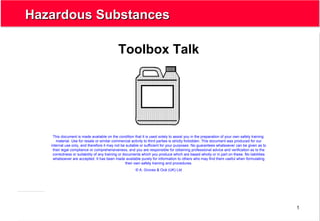07 chemicals toolbox1g
- 1. 1 Hazardous SubstancesHazardous Substances Toolbox Talk This document is made available on the condition that it is used solely to assist you in the preparation of your own safety training material. Use for resale or similar commercial activity to third parties is strictly forbidden. This document was produced for our internal use only, and therefore it may not be suitable or sufficient for your purposes. No guarantees whatsoever can be given as to their legal compliance or comprehensiveness, and you are responsible for obtaining professional advice and verification as to the correctness or suitability of any training or documents which you produce which are based wholly or in part on these. No liabilities whatsoever are accepted. It has been made available purely for information to others who may find them useful when formulating their own safety training and procedures. © A. Groves & Océ (UK) Ltd
- 2. 2 Hazardous SubstancesHazardous Substances  What substances are hazardous and why?  Intrinsically hazardous e.g. Cyanide  Hazardous in certain situations, such as Place e.g. solvents in unventilated areas Temperature e.g. flammable liquids  Cause an unsafe situation e.g. Spilt oil is very slippery  Almost ALL substances have some potential to be hazardous! e.g. Nitrogen causes ‘the bends’ in divers
- 3. 3 Intrinsically Hazardous SubstancesIntrinsically Hazardous Substances ÔÅÆ COSHH (Control of Substances Hazardous to Health Regulations) ÔÅÆ Defines a list of substances which is published annually ÔÅÆ Regulations specify the exact symbols and words required on the container ÔÅÆ Warning Symbols ÔÅÆ Risk Phrases (R..) ÔÅÆ Safety Phrases (S..)
- 4. 4 Warning SymbolsWarning Symbols If inhaled, ingested or penetrates the skin: ÔÅÆ Toxic ÔÅÆ May cause serious illness or death ÔÅÆ Corrosive ÔÅÆ May damage or destroy living tissue (the effect may be delayed)
- 5. 5 Warning SymbolsWarning Symbols ÔÅÆ Harmful ÔÅÆ May cause some health problems ÔÅÆ Irritant ÔÅÆ May cause inflammation
- 6. 6 Warning SymbolsWarning Symbols ÔÅÆ Explosive ÔÅÆ Highly or Extremely Flammable ÔÅÆ Has a flash point (i.e. easily ignited) at room temperature or below
- 7. 7 Warning SymbolsWarning Symbols ÔÅÆ Oxidizing ÔÅÆ Supports the combustion of other substances by generating oxygen ÔÅÆ Harmful to the environment ÔÅÆ May cause damage to aquatic life or plants
- 8. 8 Risk Phrase ExamplesRisk Phrase Examples ÔÅÆ R14: Reacts violently with water ÔÅÆ R22: Harmful if swallowed ÔÅÆ R36/37/38: Irritating to eyes,respiratory system and skin ÔÅÆ R42/43: may cause sensitisation by inhalation and skin contact
- 9. 9 Safety Phrase ExamplesSafety Phrase Examples ÔÅÆ S51: Use only in well-ventilated areas ÔÅÆ The area that matters is that immediately around your head - the vapour that you breathe in. ÔÅÆ S2: Keep out of reach of children ÔÅÆ S20: When using, do not eat or drink ÔÅÆ S24: Avoid contact with skin ÔÅÆ S37/39: Wear suitable gloves and eye/face protection
- 10. 10 4 Mandatory Rules4 Mandatory Rules 1. Read the label and instructions 2. Do EXACTLYEXACTLY what they say ÔÅÆ Proper use ÔÅÆ Ventilation ÔÅÆ No flames, smoking or sources of ignition ÔÅÆ Wear appropriate Personal Protective Equipment ÔÅÆ e.g. Eye protection, Correct gloves, Apron etc. ÔÅÆ Handling and storage ÔÅÆ Spill control ÔÅÆ Emergency precautions and procedures
- 11. 11 4 Mandatory Rules4 Mandatory Rules 3. Ensure the right conditions ÔÅÆ No distractions ÔÅÆ No interruptions ÔÅÆ No passers by ÔÅÆ CONCENTRATE! 3.3. Dispose of waste correctlyDispose of waste correctly
- 12. 12 3 more points3 more points ÔÅÆ Never transfer a hazardous substance to another container unless it is designed and labelled correctly. ÔÅÆ Keep containers tightly closed ÔÅÆ It is the invisible vapour from a solvent or other petroleum-based product which is even more dangerous than the liquid. ÔÅÆ It is heavier than air and may be ignited by a spark or flame some distance from the liquid. ÔÅÆ It may build up to dangerous concentrations where there is little airflow.
- 13. 13 3 more points3 more points ÔÅÆ Changing a gas cylinder (inc BBQ etc) ÔÅÆ A small leak can produce a large volume of gas, which can cause an explosion or a fierce fire ÔÅÆ Change or connect the cylinder to an appliance in the open air ÔÅÆ Never have a naked flame near an gas cylinder which is being changed ÔÅÆ Check hoses regularly ÔÅÆ Store spare cylinders outside, but not below ground level ÔÅÆ Lock cylinders away from children
- 14. 14 P.A.U.S.E.P.A.U.S.E. P.A.U.S.E. for thought ÔÅÆ PPlan each task ÔÅÆ AAnalyse what might happen ÔÅÆ UUnexpected - be prepared ÔÅÆ SSlipping, tripping & sprains ÔÅÆ EEntanglement P.A.U.S.E. for thought ... think safety A millisecond makes all the difference
- 15. 15 To concludeTo conclude  Please think about what you have seen in this presentation.  Injuries hurt. Pain isn’t pleasant.  Safety = 100% concentration 100% of the time  You have choices about your life.
Editor's Notes
- Every time that you do anything, pausing for a millisecond or two prevents complacency and ensures neither you nor anyone else gets injured – and that the job is done right first time.















